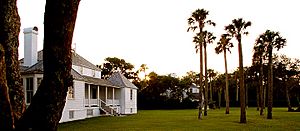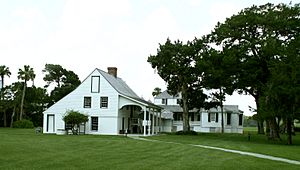Anna Madgigine Jai Kingsley facts for kids
Quick facts for kids
Anna Madgigine Jai Kingsley
|
|
|---|---|
| Born | 18 June 1793 |
| Died | April or May 1870 |
| Nationality | Kingdom of Jolof |
| Occupation | Wife, plantation manager, slave owner |
Anna Madgigine Jai Kingsley (born Anta Madjiguène Ndiaye, June 18, 1793 – April or May 1870) was a strong and important woman from West Africa, specifically from what is now Senegal. She was taken from her home and sold into slavery in Cuba. There, she was bought by a plantation owner and slave trader named Zephaniah Kingsley, who later married her.
After Kingsley's death, Anna became a successful plantation manager and slave owner herself. She was a free Black woman in early 19th-century Florida. Her life story shows how she overcame many challenges in a difficult time.
Contents
Early Life in Africa

Anna was born Anta Majigueen Ndiaye in 1793 in Senegal. Her family was part of the Wolof people. Her father was a leader, and some people called her a princess, though she never used that title herself.
When Anna was about 13 years old, she was captured during a war in her region. Many people were taken from their homes during these conflicts. She was then sent to Cuba to be sold.
Marriage and Freedom
In Cuba, Anna was bought by Zephaniah Kingsley. He was a wealthy plantation owner and slave trader. Anna and Zephaniah had four children together. They were married in a traditional African ceremony, not a Christian one.
Kingsley freed Anna in 1811 when she turned 18. He also made sure their children would be free. This was very important because if he had died before freeing them, Anna and her children could have been sold as slaves.
Anna was given important jobs managing Kingsley's plantations in East Florida. At that time, Florida was ruled by Spain.
Life at Laurel Grove
Kingsley owned a successful plantation called Laurel Grove near the St. Johns River. It grew oranges, cotton, and other crops. More than a hundred enslaved people worked there. Anna lived with Kingsley in his large house.
At Laurel Grove, Kingsley used a "task system" for work. Enslaved people were given specific tasks to complete each day. Once finished, they could use their extra time for other activities, like growing their own food or making crafts to sell. This system helped the plantation become very successful.
Anna became a trusted manager at Laurel Grove. Kingsley often traveled for his shipping and slave trading businesses. He relied on Anna to run the plantation in his absence. He described her as "very capable" and said she could manage the plantation as well as he could.
In 1813, as a free woman, Anna asked the Spanish government for land. She was given 5 acres in Mandarin, Florida. She started her own farm and bought 12 enslaved workers.
That same year, Americans tried to take control of Florida from Spain. These "Patriots" raided towns and plantations, capturing Black people and selling them into slavery, even if they were free. The Patriots took over Laurel Grove. To stop them from using the plantation, Anna bravely burned it down herself, with the Spanish watching. She also burned her own homestead to prevent the Patriots from using it. For her courage, the Spanish government later gave Anna a large land grant of 350 acres.
Fort George Island
In 1814, Zephaniah Kingsley bought another plantation on Fort George Island. Anna helped manage this new plantation while Kingsley was away. They built a separate kitchen with a room above it where Anna and her children lived. This was called the "Ma'am Anna House." Living separately from husbands was a common custom in West Africa, especially in families where men had more than one wife. Kingsley later took three other wives.
The slave cabins on Fort George Island were built from a strong material called tabby. This was made by crushing oyster shells and mixing them with water and sand. Anna may have known how to make tabby because it was used in West Africa. The cabins were arranged in a unique semi-circle, which some historians think Anna might have designed, similar to villages in Africa.
Anna had her fourth son, John, in 1824. She also became friends with a white woman named Susan L'Engle, who called Anna "the African princess."
Moving to Haiti and Returning to Florida
After the United States took control of Florida in 1822, new laws were passed that made life harder for mixed-race families and free Black people. These laws worried Kingsley. In 1835, he moved most of his family and many of his workers to Haiti. Slavery was not allowed in Haiti, so his enslaved workers became indentured servants, meaning they worked for a set time to earn their freedom.
Kingsley died in 1843. After his death, his white relatives tried to challenge his will. They wanted to prevent Anna and her children from inheriting his property. Florida law at the time did not recognize mixed-race marriages or allow Black people to own property.
Anna returned to Florida in 1846 to fight for her family's inheritance. Despite the difficult racial climate, the court sided with Anna. They honored a treaty between the U.S. and Spain that said free Black people born in Florida before 1822 had the same rights they had under Spanish rule. Anna won the case, protecting her family's future.
Anna settled in Jacksonville, Florida. When the American Civil War began, she supported the Union side. She died in 1870 at the age of 77.
Today, the National Park Service protects Kingsley Plantation on Fort George Island. It is part of the Timucuan Ecological and Historic Preserve and helps tell the story of Anna and Zephaniah Kingsley.
Descendants
Anna Kingsley has many descendants today. They identify as white, Black, or Latino and live in the United States and the Dominican Republic. Her Black descendants in Jacksonville, Florida, became a very important part of the Black upper class for over a century. For example, her great-granddaughter, Mary Kingsley Sammis, married Abraham Lincoln Lewis, who was Florida's first Black millionaire. Their descendants include famous people like academic Johnnetta Betsch Cole and jazz musician John Betsch.
In 2018, celebrations were held in Senegal to honor Anna Kingsley. A street in the town of Rufisque was named after her, marking her symbolic return to her homeland.
Works about Anna Kingsley
Theater
- Madjigeen, a musical by Jennifer Chase, first performed in 2005.
- Anna is featured in a short documentary from the 2018 collection Uncovering Jax.
Books
- Anna's daughter Mary is the main character in the 2008 children's book The Treasure of Amelia Island, by M. C. Finotti.
See also
- Ana Gallum
- Suzanne Amomba Paillé
- Elisabeth Samson
Images for kids




